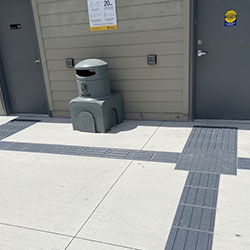









As Canada continues its rapid urbanization, city planners face the crucial challenge of making built environments accessible for all people, including vulnerable groups like citizens with visual or mobility impairments. While great strides have been made in accessibility over the decades, many public spaces still pose navigation challenges for those with disabilities.
This is where tactile wayfinding solutions come in as an indispensable tool for enhancing accessibility. Tactile wayfinding leverages textured ground surface indicators that can be felt underfoot or with a cane to guide users and impart crucial spatial information to pedestrians with visual disabilities.
In this blog, we delve into the world of tactile wayfinding and how it is fast becoming a vital investment for forward-thinking Canadian cities aiming to ensure accessibility and foster inclusion as they continue expanding.
Tactile wayfinding refers to embedded tactile ground surface indicators that outline designated pedestrian circulation paths and key points of interest across public landscapes like transit hubs, parks, and plazas. They provide a tangible navigation channel that users with vision impairments can detect through their feet or canes.
Tactile wayfinding solutions feature flat-topped bars, cone bars, or raised dots arranged in the direction of travel. This consistent alignment perpendicularly to the path of movement provides essential orientation cues. Users can trace the patterns with their foot or cane to discern the safe walking direction.
Well-implemented tactile wayfinding fulfils two essential functions:
Together, these functions foster safer mobility and independence for the visually impaired. They can navigate safely on their own without over-reliance on aids like sighted guides or verbal directions.
Canada is rapidly urbanizing, with over 80% of Canadians residing in large metro areas as of 2016. This urban population boom makes accessibility a prime concern for cities.
The number of Canadians with age-related vision loss is also rising steadily with our aging population. Over 1.5 million Canadians currently live with vision disabilities. And this is expected to double by 2031.
These demographic factors compound the need for tactile wayfinding across Canadian cities. Let's look at how tactile surfaces can foster accessibility in our urban public spaces:
Tactile guidance paths on sidewalks and crosswalk bars at intersections guide pedestrians safely across busy vehicular routes. Tactile indicators at curbs alert users to the transition between pedestrian and traffic zones.
Tactile routes at metro stations, bus terminals, airports, and train platforms enable intuitive access between arrival points and ticketing/information kiosks, washrooms, boarding zones, and staircases.
Sprawling open public spaces can be disorienting to navigate, but tactile paths leading through parks, squares, and markets make them more welcoming.
Library squares, courthouse stairs, and city hall entrance plazas become accessible when tactile surfaces lead the way to their doorsteps.
Retail areas thrive on footfalls. Tactile paving along storefronts, restaurants, and malls keeps them connected, safe, and navigable.
By retrofitting these key zones with compliant tactile wayfinding, cities gain the building blocks of an accessible public realm to serve all citizens.
To ensure consistent non-visual communication and compliance with regulations, tactile wayfinding must adhere to accessibility codes and standards. In Canada, key regulations include:
Conforming with these codes ensures the tactile installations safely and effectively serve the mobility needs of Canadians with vision disabilities.
When planning tactile wayfinding for public realm projects, urban designers and city planners should consider the following:
With numerous tactile products available, expert guidance helps select solutions tailored to each application's unique specifications and accessibility needs.
Key public spaces that should integrate compliant tactile wayfinding include sidewalks, pedestrian crossings, parks, transit platforms, shopping districts, office plazas, airports, government buildings, hospitals, educational institutions, and recreational facilities.
Tactile wayfinding provides essential non-visual orientation cues and directional guidance, allowing people with vision disabilities to navigate safely and independently. It fosters mobility and spatial awareness.
The main regulations are the Accessibility for Ontarians with Disabilities Act (AODA), CSA Standard B651, the National Building Code of Canada, and various provincial and municipal building codes.
Strong visual contrast between tactile wayfinding bars and the surrounding surface, through colour and brightness differentiation, is recommended by standards for maximum visibility.
They can retrofit existing spaces with surface-applied tiles or install new tactile surfaces built into concrete. Consulting experts ensure standards compliance and optimal product selection tailored to each site.
Well-designed cities put people first. For too long, disabled citizens have faced exclusion from the seamless enjoyment of public spaces. Thoughtfully planned tactile wayfinding finally brings accessibility to the core of urban design.
These textured guidance networks transform disorienting surroundings into intuitive, navigable places, empowering people with vision disabilities. Integrating compliant tactile wayfinding solutions is an ethical imperative and intelligent investment that positions Canadian cities to lead the charge toward inclusive, barrier-free communities that leave no one behind.
As Canada's foremost tactile solutions provider, Tactile Solution Canada partners with cities across the nation to make public realm accessibility a reality. Our expertise in code-compliant solutions tailored to each project's unique needs streamlines the integration of tactile wayfinding.
To equip your city with world-class accessibility, explore our wide range of wayfinding solutions today. Let us pave the path to a brighter future.
